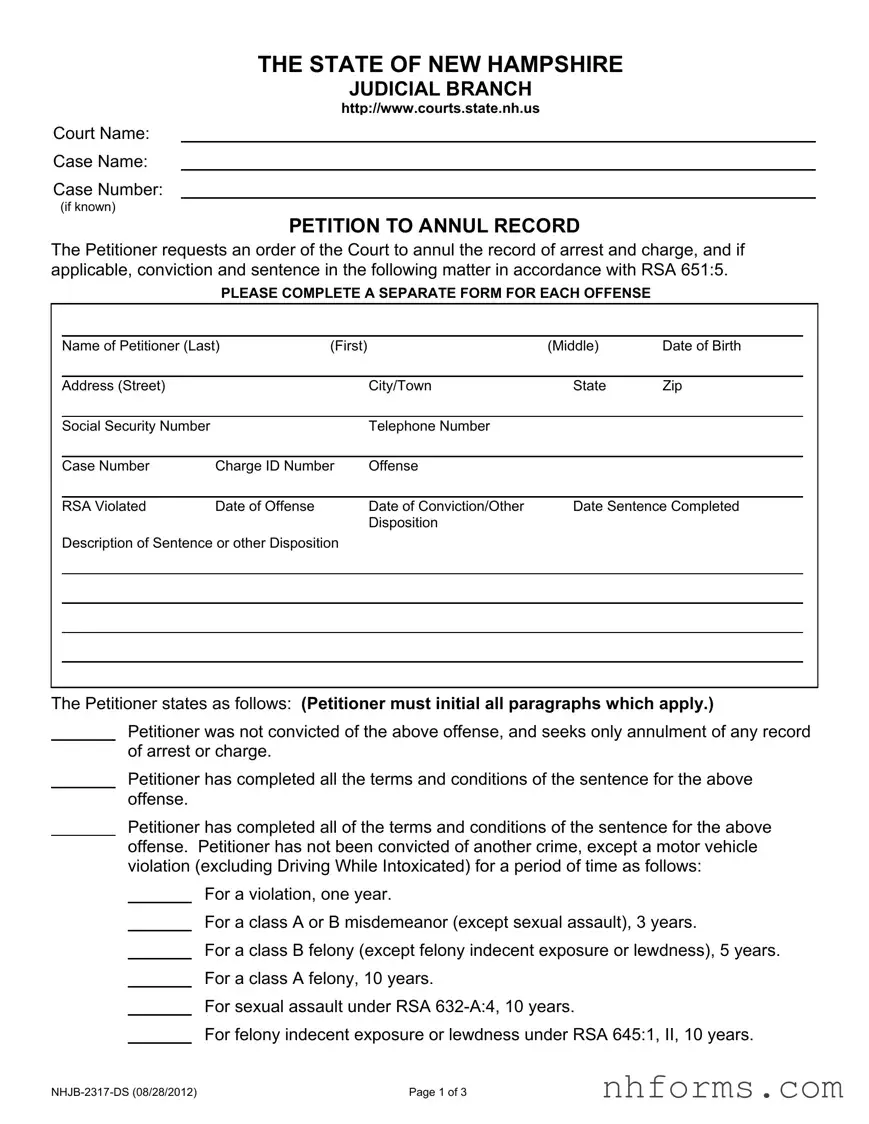THE STATE OF NEW HAMPSHIRE
JUDICIAL BRANCH
http://www.courts.state.nh.us
Court Name:
Case Name:
Case Number:
(if known)
PETITION TO ANNUL RECORD
The Petitioner requests an order of the Court to annul the record of arrest and charge, and if applicable, conviction and sentence in the following matter in accordance with RSA 651:5.
PLEASE COMPLETE A SEPARATE FORM FOR EACH OFFENSE
|
|
|
|
|
|
|
|
|
Name of Petitioner (Last) |
(First) |
|
(Middle) |
Date of Birth |
|
|
|
|
|
|
|
|
|
|
Address (Street) |
|
|
City/Town |
State |
Zip |
|
|
|
|
|
|
|
|
|
|
Social Security Number |
|
|
Telephone Number |
|
|
|
|
|
|
|
|
|
|
|
Case Number |
Charge ID Number |
Offense |
|
|
|
|
|
|
|
|
|
|
|
RSA Violated |
Date of Offense |
|
Date of Conviction/Other |
Date Sentence Completed |
|
|
|
|
|
Disposition |
|
|
|
|
Description of Sentence or other Disposition |
|
|
|
|
|
|
|
|
|
|
|
|
|
|
|
|
|
|
|
|
|
|
|
|
|
|
|
|
|
|
|
|
|
|
|
|
|
|
|
|
|
|
|
|
The Petitioner states as follows: (Petitioner must initial all paragraphs which apply.)
Petitioner was not convicted of the above offense, and seeks only annulment of any record of arrest or charge.
Petitioner has completed all the terms and conditions of the sentence for the above offense.
Petitioner has completed all of the terms and conditions of the sentence for the above offense. Petitioner has not been convicted of another crime, except a motor vehicle violation (excluding Driving While Intoxicated) for a period of time as follows:
For a violation, one year.
For a class A or B misdemeanor (except sexual assault), 3 years.
For a class B felony (except felony indecent exposure or lewdness), 5 years.
For a class A felony, 10 years.
For sexual assault under RSA 632-A:4, 10 years.
For felony indecent exposure or lewdness under RSA 645:1, II, 10 years.
NHJB-2317-DS (08/28/2012) |
Page 1 of 3 |
Case Name:
Case Number:
PETITION TO ANNUL RECORD
The Petitioner has not been convicted of any violent crime, of any crime of obstruction of justice, or of any offense for which an extended term of imprisonment under RSA 651:6 was imposed.
The time requirements for annulment under RSA 651:5, III have been met for any and all crimes for which the Petitioner has been convicted.
The Petitioner was convicted of a misdemeanor prior to January 1, 1995 and is exercising the option to apply for annulment under the laws in effect at the time of sentencing. A Petition to Annul in conformance with the prior law is attached.
The Petitioner believes an order granting annulment will assist in petitioner’s rehabilitation and is consistent with the public welfare.
Date |
Signature of Petitioner |
|
|
|
Signature of Counsel |
|
|
|
Name |
|
|
|
Address |
|
|
|
|
|
|
|
|
|
|
|
State of |
|
, County of |
|
|
This instrument was acknowledged before me on |
|
|
|
|
by |
|
|
My Commission Expires |
|
|
|
|
|
|
|
|
Affix Seal, if any |
|
Signature of Notarial Officer / Title |
|
NHJB-2317-DS (08/28/2012) |
Page 2 of 3 |

Case Name:
Case Number:
PETITION TO ANNUL RECORD
FOR COURT USE ONLY:
ON THE PETITION TO ANNUL RECORD OF ARREST OR CONVICTION AND SENTENCE
The Court having found that notice of the forgoing petition was given in accordance with law, and having reviewed the investigative report of the Department of Corrections made in accordance with statute, finds that annulment of the applicant’s record will assist in the applicant’s rehabilitation and will be consistent with the public welfare and the requirements of law,
IT IS THEREFORE ORDERED AND CERTIFIED
That the record of the charge and disposition of dismissal, acquittal or nolle prosequi in the above referenced matter, together with any record of arrest or charge therein, is hereby annulled. The applicant has shown that issuance of this order is warranted under the statute. The clerk shall issue an appropriate Certificate of Annulment.
That the record of conviction and sentence in the above entitled case, together with any record of arrest or charge therein, is hereby annulled. The clerk shall issue an appropriate Certificate of Annulment.
The Court DENIES the applicant’s petition for the following reason(s):
Date |
|
Justice |
|
FOR DISTRICT DIVISION USE ONLY |
On |
|
, petition and notification of pending petition for annulment sent to: |
AG/County Atty., Arresting Agency, State Police Records.
Other
NHJB-2317-DS (08/28/2012) |
Page 3 of 3 |



